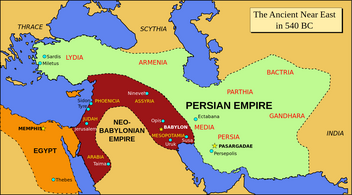
Persia Biblical Map
Persia, known today as Iran, holds significant importance in the biblical narrative, particularly in the context of the Old Testament. The geographic and historical presence of Persia and its interaction with the people of Israel provide a rich backdrop to understanding key biblical events and prophecies. This exploration delves into the geographical context of ancient Persia, its significance in the Bible, and the key biblical events associated with it.
Geographical Context of Ancient Persia[]
Location and Landscape[]
Ancient Persia, located in what is now modern-day Iran, was situated in the Middle East, bridging the East and West. It encompassed a vast area, extending from the Persian Gulf in the south to the Caspian Sea in the north, and from Mesopotamia in the west to the Indus River in the east.
Climate and Terrain[]
The region's climate and terrain were diverse, ranging from arid deserts to fertile valleys, high mountains, and expansive plains. This diversity influenced the agricultural and economic practices of the Persian Empire.
Strategic Importance[]
Persia's geographical position made it a strategic bridge between various civilizations, facilitating trade and cultural exchange. Its location also played a crucial role in its military campaigns and expansion.
Significance of Persia in the Bible[]
The Persian Empire in Biblical History[]
The Persian Empire emerged as a dominant power after the fall of the Babylonian Empire. It is most prominently featured in the Bible during the period of the Jewish exile and the subsequent return to the land of Israel.
Cyrus the Great[]
One of the most significant figures is Cyrus the Great, the founder of the Persian Empire. He is mentioned in the books of Ezra and Isaiah. Cyrus is renowned for his decree that allowed the Jewish exiles in Babylon to return to Jerusalem and rebuild the Temple, as noted in Ezra 1:1-4. This act fulfilled the prophecy of Isaiah (Isaiah 44:28; 45:1), who named Cyrus as the anointed one who would facilitate God's plan.
Role in Jewish Restoration[]
The Persian period was a time of restoration for the Jewish people. Under Persian rule, they were allowed to return to their homeland, rebuild the Temple, and reestablish their religious and cultural identity, as narrated in the books of Ezra and Nehemiah.
Esther and Mordecai[]
The Book of Esther, set in the Persian city of Susa (Shushan), highlights another significant interaction between the Jewish people and the Persian Empire. It tells the story of Esther, a Jewish queen of Persia, and her cousin Mordecai, who saved their people from a plot to destroy them. The events of Esther give insight into the life of the Jewish diaspora in Persia and the celebration of Purim.
Influence on Jewish Thought and Culture[]
The Persian period influenced Jewish religious thought, culture, and the Hebrew language. Aramaic, used widely in the Persian Empire, became a common language among the Jews of that era.
Key Biblical Events Associated with Persia[]
The Return from Exile[]
The edict of Cyrus in 539 BCE marks the end of the Babylonian exile and the beginning of the return to Jerusalem, a pivotal event in Jewish history.
Rebuilding of the Temple[]
The reconstruction of the Second Temple in Jerusalem started under Cyrus and completed under Darius I, is a central event during the Persian period. This was a significant moment of religious renewal for the Jewish people.
The Story of Esther[]
The events of the Book of Esther, including Mordecai's rise to power and Esther's influence on King Ahasuerus (Xerxes I), are set against the backdrop of the Persian court and highlight the presence and influence of the Jewish community in Persia.
Conclusion[]
The Persian Empire's role in biblical history is multifaceted, influencing the course of Jewish history through both direct interventions, such as Cyrus's decree, and its cultural and political impact. Understanding Persia's geographical and historical context provides a deeper appreciation of its role in the biblical narrative, shedding light on the interplay between geopolitics, culture, and religious history in the ancient world. The period of Persian rule in the Bible represents a time of transition, challenge, and restoration for the Jewish people, leaving a lasting imprint on their collective memory and identity.
